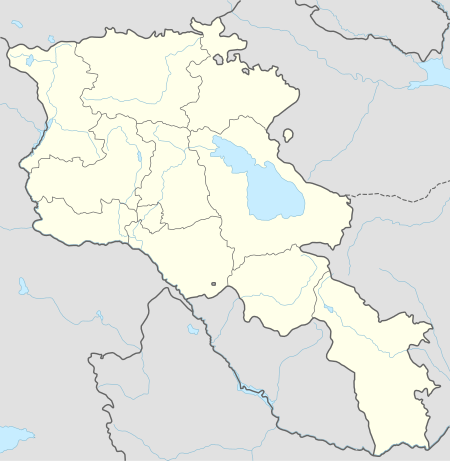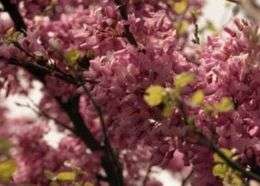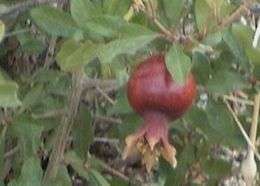Shvanidzor
Shvanidzor (Armenian: Շվանիձոր, pronounced [ˈʃvɑnidzɔɾ]; also Astazur or Shvandor) is a village and rural community (municipality) in the South-East of Armenia in Syunik province (marz). It borders with Islamic Republic of Iran. Distance between the community and Yerevan – 410 km, between the community and Kapan regional center – 102 km, between the community and the main highway- 17 km. The distance between the community and newly built Tsav-Shikahogh highway (which is alternative way to Iran) is 700m. Community lands stretch from 450 to 2864m, on the southern slopes of Meghri mountain range (Tsav-Shvanidzor pass), whereas the settlement itself is located in the forestry area at the bottom, at 630-760m above the sea level, in Astghadzor (Astazor) gorge.
Shvanidzor Շվանիձոր | |
|---|---|
community | |
Community houses | |
 Shvanidzor | |
| Coordinates: 38°56′34″N 46°22′37″E | |
| Country | |
| Province | Syunik |
| Area | |
| • Total | 42.22 km2 (16.30 sq mi) |
| Population (2011) | |
| • Total | 312 |
| • Density | 7.4/km2 (19/sq mi) |
| Time zone | UTC+4 ( ) |
| • Summer (DST) | UTC+5 ( ) |
| Shvanidzor at GEOnet Names Server | |
The National Statistical Service of the Republic of Armenia (ARMSTAT) reported its population was 306 in 2010,[2] down from 330 at the 2001 census.[3] Main occupations are gardening, animal husbandry, bee-keeping.
History
According to local historical sources, Shvanidzor community was founded in 13th century and counted more than 700 households, in the place of historic settlement of Areviq. The community lands were cultivated during 700 years, which resulted in the formation of agro-landscapes. Due to lack of irrigation and low land fertility the community was relocated several times. In the vicinity of the village there are numerous remnants of the 17th-18th century dwellings.
The community is known for its medieval kahrezes (qanat), a system of underground water channels and intake facilities. These deep channels are located 50-60m from each other. There are 5 kahrezes in Shvanidzor. Four of them were constructed in the 12th-14th centuries, even before the village was founded. The fifth kahrez was constructed in 2005. Potable water runs through I, II and V kahrezes. Kahrez III and IV are in quite poor condition. In summer, especially in July and August, the amount of water reaches its minimum, creating critical situation in the water supply system.
Culture
Shvanidzor is famous for its historical monuments. Close to the community there is an old bridge (17th century), as well as Gyumerants, St. Stepanos (17th-19th centuries), Berdikar (12th-13th century) churches. There is also an aqueduct of 16th century. This currently functioning aqueduct is the most important historical monument of such type remaining from the medieval times in Armenia.
Having a long history, Shvanidzor has preserved several specific traditions and rituals. The most celebrated holidays were Easter, Palm Sunday, Wine Blessing etc. Pilgrimage was also quite spread among the inhabitants. For many centuries Shvanidzor has been a residence of meliks, which is reflected in many legends and traditions.
The community members were traditionally engaged in hunting, fishing, animal husbandry, gardening, winery. Part of the community were skillful craftsmen, especially smiths, tailors, carpenters, masons, mat weavers etc.
Nature
Shvanidzor is located 10 km away from Shikahogh State Preserve. Vicinity of the village have been designated as Prime Butterfly Area.[4]
Flora


Shvanidzor is located in dry tropics. The indicators of tropics are wild pomegranate, wild fig and numerous other plants. The majority of the plants are xerophile, represented by xeromorphous shrubs. Green leafy plants are represented by araxian (Quercus araxina) and oriental oak (Q. macranthera), Georgian maple (Acer ibericum), as well as plane-tree, ash-tree, beech etc. Shvanidzor and its vicinities are the only places in the South Caucasus, where 2 types of European redbud (Judas tree)- Cercis griffithii Boiss. and С. siliquastrum L. Dry alpine meadows are covered with scarce shrubs and remind of desert. However, there are numerous wild herbs, including officinal, edible as well as wild relatives of cultivated plants.
Fauna
The mammals living in the area are quite known, such as Caucasian bear (Ursus arctos syriacus), Bezoarian goat (Capra aegagrus aegagrus), Armenian mouflon (Ovis orientalis gmelinii), Persian leopard (Panthera pardus tullianus), as well as badger, lynx, wild boar, roe deer, which are listed in the Red Book. Apart from that there are also long-eared hedgehog and 3 types of bats that are listed as endangered. Hunting and poaching still causes harm to these species, though from mammals, it is only allowed to hunt fox and hare.
Out of 66 species of birds listed in the Red Book, 15 can be met in Shvanidzor, which are Acciper Brevipes, Circaetus gallicus gallicus, Aquila rapax orientalis, Aquila chrysaetos fulva, Gypaetus barbatus aereus, Gyps fulvus fulvus, Merops superciliosus persicus, Sylvia hortensis crassirostris, Oenanthe xanthoprimna chrysopygia, Monticola saxalitis saxalitis, Luscinia svecica occidentalis, Remiz pendulinus menzbieri, Parus lugubris.
7 types of reptiles from the 11 in the Red Book can be met in Shvanidzor: Testudo graeca, Eumeces schneiderii, Mabuya aurata, Rhynchocalamus melanocephalus, Telescopus fallax ibericus, Elaphe (Zamenis) hohenackeri, Montivipera raddei.
References
- "Syunik regional e-Governance System" (in Armenian). Syunik Province provincial government. Click on link entitled "Համայնքներ" (community) and search for the place by Armenian name.
- "Marzes of the Republic of Armenia and Yerevan City in Figures, 2010" (PDF). Statistical Committee of Armenia.
- Report of the results of the 2001 Armenian Census, Statistical Committee of Armenia
- Butterfly Conservation Armenia http://www.butterfly-conservation-armenia.org/shvanidzor.html

